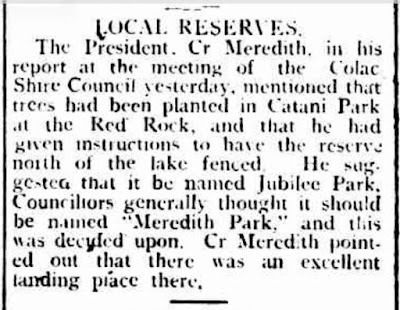The Age reported on February 25, 1910 that at a meeting of the Executive Council held yesterday, Mr. C. Catani, engineer-of roads, bridges and harbor works, was promoted to be chief engineer of the Public Works department. His present salary is £600 a year. Class B 2, to which he has been raised, carries a salary ranging from a minimum of £560 to a maximum of £650.
The Age February 25, 1910.
So it appears that officers in Class B 2, could be paid as much as £650 per annum, but The Argus on the same day said that Carlo's appointment came with a salary of £600 a year and that No increase was made in Mr. Catani's salary, so he had taken on additional responsibilities for no extra money.
Carlo must have eventually had a salary increase as Punch reported on October 24, 1912 on some political gossip about the appointment of the new Agent-General in London and Other important State appointments are contingent on the carrying of the Main Roads Bill this session. The Chairman of the Main Roads Board is to receive £800 a year. He will almost certainly be Mr. Catani, who has been thinking out the engineering problems of the Public Works Department for many years, and yet gets only £650 a year, a remuneration which the average successful engineer in private practice would scorn. But that is the way with Victorian Governments. They stop short with their salaries for just those valuable expert officers whose brain work means success or disaster to the State's largest public undertakings. Ministers get so little themselves - only from £1000 to £1200 - that they cannot see that it pays the public to pay handsomely for the best expert knowledge.
From this we learn that Carlo was now on £650 per annum, the maximum for Class B 2 Public Servant; that Government Ministers earnt between £1000 to £1200; that Carlo should have been paid more and the Punch considered that he would be a suitable Chairman of the Main Roads Board, which paid £800 per annum. Did Carlo ever apply for the Chairman's role? Returning to Punch, in January 1913 they reported that he had declined the position. It may have been because his own position was reclassified in late 1912 and that his salary increased to around £800 per annum (Bendigo Independent). In the end the organization was known as the Country Roads Board and the first chairman was William Calder (1860 - 1928). The Calder Highway is named for Mr Calder and you can read his entry in the Australian Dictionary of Biography, here.
Punch October 24, 1912
When the role of Chief Engineer of the Public Works Department was created the role of Chief Architect was also created. The Herald of May 4, 1910 reported that Lieutenant-Colonel G. W. Watson, a senior architect of the Public Works Department, has been appointed Chief Architect of that Department at a salary of £560 a year. This was £40 per annum less than Carlo. Was Lieutenant-Colonel George William Watson worried about this? Don't know, but he sadly died in July 1915 and Samuel Charles Brittingham was appointed acting Chief Architect. Due to the War no permanent appointments were being made. Mr Brittingham retired in 1922.
Of course, we do not know how Carlo spent his money, but he obviously used some of it to support community groups and works in St Kilda. This article, below, published after he died, said that he had voluntarily worked for St Kilda Foreshore Committee for 12 years and had even lent the group £1,400 to help it continue it work - that's two years worth of salary - a generous amount of money. Carlo did not leave a will but his probate papers valued his estate at just over £3,645 - £1,448 in real estate and £2,245 in personal property.
Carlo's generosity. The memorials to Carlo came a bit later - the gardens designed by Carlo on the St Kilda foreshore were named after him in 1927 and the Memorial Clock Tower was unveiled in 1932.
Prahran Telegraph August 17, 1918
http://nla.gov.au/nla.news-article75258567
A report mentioned Carlo's generous loan to the St Kilda Foreshore Committee. Sadly, the reported short sighted, unenterprising state of mind that existed in the Government at the time, still exists in Governments today - so no change there.
The Age of November 25, 1925
http://nla.gov.au/nla.news-article155677079
An article published in The Age of November 25, 1925 was scathing in reporting this matter, of Carlo having to lend money to the Foreshore Committee in order that they could carry out their beautification works.
A report mentioned Carlo's generous loan to the St Kilda Foreshore Committee. Sadly, the reported short sighted, unenterprising state of mind that existed in the Government at the time, still exists in Governments today - so no change there.
The Age of November 25, 1925
http://nla.gov.au/nla.news-article155677079
To put these salaries that I have mentioned above into perspective the 1915 Commonwealth Year* book has lists of average wages for the time and a metal worker such as a blacksmith earnt about £170 per annum and and a general labourer about £124. A male shop assistant or clerk was on £91 to £130 and a female on £54 to £78. Clearly, compared to the average man in the street, Carlo was doing well, however given the massive contribution that he made to Victoria and the esteem and affection with which he was held then I must agree with the Punch writer that They [the Victorian Government] stop short with their salaries for just those valuable expert officers whose brain work means success or disaster to the State's largest public undertakings.
I have created a list of articles on Trove about Carlo's salary - access it here. All articles referenced here are on the list.
























